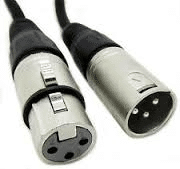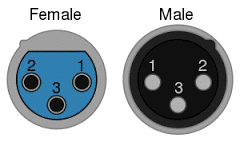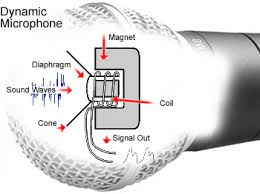In part one of this blog series, the drawbacks of dropping a piezo-electric microphone were discussed. While dropping a microphone looks cool, the crystal in these microphones were very brittle and dropping these microphones would mean that they were “ex-microphones”
In more modern days, microphones tend to be either dynamic or capacitor. And if you are over age 50, these capacitor microphones used to be called condenser microphones.
A dynamic microphone is actually quite simple in its design. A metallic diaphragm, or a plastic diaphragm with magnetic substance on it sits in the center of a coil of wire. The input to the microphone causes the diaphragm to move and this sets up a current in the surrounding coil of wire. The current is sent to a pre-amplifier and is the input to the recording or PA system that is then used. This is actually something that could have been designed a million years ago if we knew about electricity back then. There is nothing too special about a dynamic microphone.
The diaphragm of a dynamic microphone is quite light, but relatively speaking is heavier than that of a capacitor microphone…and this has some importance for music and other quick percussive sounds.
In contrast, a capacitor microphone uses a transducer that is very much like a capacitor; hence the name. A capacitor is a device where two parallel plates sit side by side. The rear plate is charged and as such capacitor microphones requires a power source to keep it charged. The front plate is a very light diaphragm that moves in synchrony with the input sound or music. High levels of sound cause the plate to move closer to the charged rear plate and quieter levels have less diaphragm movement. A current is transmitted from the charged rear plate that is a replica of the movement of the light microphone diaphragm.
There are two differences between a dynamic microphone and a capacitor microphone. A capacitor microphone needs a power source and because of its lighter diaphragm, it can transduce higher levels of music with a better fidelity. For speech and quieter non-percussive music, there should be no difference.
Typical maximum transduction limits on dynamic microphones are in the 112-115 dB SPL range and those of capacitor microphones are in the 130-135 dB SPL range.
Another difference is that a capacitor microphone, having a relatively light diaphragm, can respond quicker to a sudden percussive sound than a dynamic microphone. For percussion the capacitor microphone diaphragm can move quickly but there can be some delay (caused by inertia) of the more massive diaphragm used in dynamic microphones.
While this is an issue with music, there is no difference for speech. Even the most rapid speech sound such as the aspiration after a stop or an affricate, can be easily handled by a dynamic microphone.
And oh yes, why is an XLR cable connector called an XLR cable connector?
Since capacitor microphones require a power source (to keep the rear plate charged), there needs to be a power supply and this accounts for one of the three pins in the XLR connector, and the other two carry the signal. When these first became available, the Cannon Corporation had a useful 3 pin connector in their X-series of connectors. This explains the “X”. The cable would frequently be pulled out of the microphone so a Latch (L) was added… and this explains the “L”. After some use, the pins would frequently become bent and useless so the manufacturer encased the connector pin receptacle in Rubber (R) and this is where the “R” of XLR comes in.









